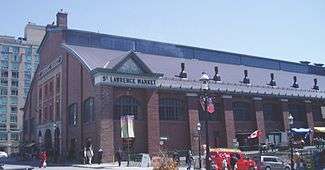St. Lawrence Market South
| St. Lawrence Market South Building | |
|---|---|
 View from north-west | |
| General information | |
| Type | Public market |
| Address | 92 Front Street East |
| Town or city | Toronto |
| Country | Canada |
| Opened |
1845 (as city hall and municipal complex) 1902 (as public market) |
| Owner | City of Toronto |
| Technical details | |
| Floor count | 2 +2(former city building) |
| Floor area | 111,458 square feet (10,354.8 m2)[1] |
| Design and construction | |
| Architect |
Henry Bowyer Lane (1845 building) John Wilson Siddall (1902 rebuild) |

The St. Lawrence Market South building is a major public market building in Toronto, Ontario, Canada. It is located on the southwest corner of Front and Lower Jarvis Streets. The south building is located at the corner of Lower Jarvis and Front Street. It, along with the St. Lawrence Market North and St. Lawrence Hall comprise the St. Lawrence Market complex. The current building was opened in 1902, and incorporated the 1845 Toronto City Hall building into the structure.[2] The building was restored during the 1970s.
Description
The building has two main floors. The upper floor is the primary space. The upper floor extends the full length of the building. It is one large open space with the large overhanging roof structure, and windows on each side. The lower level is partly underground, opening to the outdoors on the south end of the building. The lower floor does not extend the full length of the building. The market is located on the edge of the former lake shore, and the elevation drops over 10 feet (3.0 m) between the north and south ends. The south end of the lower floor opens to ground level at The Esplanade street. Surrounding the building along the east, west and south sides is a mezzanine. Seating and some tables are available.
On the upper floor, over 50 vendors sell fruits, vegetables, meats and cheeses daily, while the lower floor has a portion that is non-food. Each vendor has an allotted stall space and there are several aisles. Several stalls sell sandwiches, such as the staple back bacon sandwich, and beverages such as coffee and tea. There are also craft and art vendors and kitchen supplies.
At the north end is a remnant of the old City Hall, providing two small upper floors. It houses the Market Gallery, operated by the City of Toronto, on the second floor and a cooking school (market kitchen) on the mezzanine floor. Opened in 1979, the Market Gallery offers changing exhibitions dedicated to Toronto's history, art and culture, and programs for school and community groups. The gallery space was formerly the 19th century city council chamber from 1845 to 1899.[3]
The St. Lawrence Market is one of the two locations in Toronto that house the majority of businesses accepting the Toronto Dollar, a local currency that raises money for fighting poverty.[4] Free Wi-Fi is available throughout the South Market building, provided by Wireless Toronto.
The North Market, located on the north side of Front Street facing the South Market, houses a farmers' market each Saturday featuring 43 vendors inside the building and numerous cart vendors outside of the building, and an antiques market on Sundays.[5]
History
The building was once home to Toronto's first permanent city hall and jail house from 1845 to 1899. It was designed by English immigrant architect Henry Bowyer Lane, who also designed Little Trinity Church in 1843, Holy Trinity Church in 1847, and expansion of Osgoode Hall in 1844. Lane's design was chosen over those submitted by William Thomas, John Tully and John George Howard. Lane incorporated into his design contrasting red brick and white stone in the Georgian tradition. A “cupola” was built on the top front side of the building with a clock. Two-storey wings extended on either side of a three-storey centre block, and housed the offices of City staff and shops on the ground floor. The centre block contained the Council Chambers, Police Station # 1 and a gaol in the basement. It was built at a cost of $52,000.
The illustration below shows "New Market House", which was the Toronto City Hall from 1845-1899. The yellow brick outline of the centre part of that building can still be seen today in the front facade of the current building.
The City Hall was renovated in 1851 by William Thomas, with new shops in the wings, keystones in the arched windows and improvements to the police station and jail cells (which were reportedly subject to flooding). More improvements were made between 1868 and 1872 by Henry Langley, who designed many churches and public buildings including the Metropolitan United Church.
In 1899, the City of Toronto decided to vacate the facility and move to a new city hall located on Queen and Bay Streets designed by E. J. Lennox. A Market Commission recommended the old city hall be renovated and turned into a large marketplace. John William Siddall was the selected architect for this project. Siddall decided to demolish the cupola, the pediment and the side wings. The new steel truss roof was proposed to cover the entire building structure, allowing more open space with a high ceiling and more natural light. The North Market was also rebuilt at this time, and had a similar design to the current South building. The two buildings were joined with a glass canopy over Front Street. The South building opened in 1902 and the new North building opened in 1904.
In 1971 a consultant recommended the market be demolished. Time and Place, a citizens' group, proposed a renovation and that the former Council Chamber be converted into a "City display space." The renovations lasted from 1974 to 1978 and included the opening up of the basement for retail use, a new floor for the main level, installation of a freight elevator and new doors to accommodate increased pedestrian traffic. The renovated Council Chambers opened as the Market Gallery, an exhibition facility to showcase the City's extensive archival and art collections, on March 7, 1979.[6]
In literature
The St. Lawrence Market neighbourhood is featured extensively in the novel Old City Hall, by Robert Rotenberg.
| Wikimedia Commons has media related to St. Lawrence Market. |
 New Market House, city hall for Toronto from 1845 to 1899.
New Market House, city hall for Toronto from 1845 to 1899. St. Lawrence Market South building from the north-east
St. Lawrence Market South building from the north-east
See also
References
- ↑ "St. Lawrence Market (South) – New Lease Agreements" (PDF) (pdf). City of Toronto. Retrieved December 6, 2015.
- ↑ Historic Horizons Inc. "St. Lawrence Market, North Building Stage 1 Archaeological Background Study Final Report" (PDF) (pdf). City of Toronto. Retrieved December 5, 2015.
- ↑ http://www.toronto.ca/marketgallery.htm Market Gallery
- ↑ Barbara Turnbull, "Milestone for the `Toronto Dollar'", Toronto Star, Mar. 22, 2008.
- ↑ "St. Jacobs Market rises from the ashes after 2013 blaze". Toronto Star. June 14, 2015. Retrieved June 14, 2015.
- ↑ The History of the St. Lawrence Market Buildings. Toronto: City of Toronto. 2013.
External links
- Official site
- North Market
- South Market
- St. Lawrence Market: Photos and Updated Information
- Market Gallery - official site
- Ontario historical plaque - St. Lawrence Market
| Preceded by Temporary space at Market Square (1834-1844) |
Toronto City Hall 1845–1899 |
Succeeded by Old City Hall (Toronto) |
Coordinates: 43°38′56″N 79°22′18″W / 43.64889°N 79.37167°W